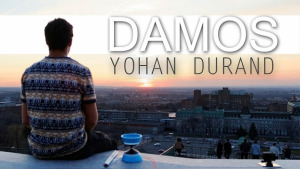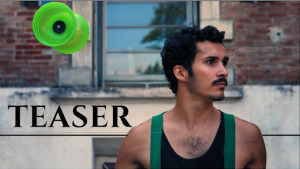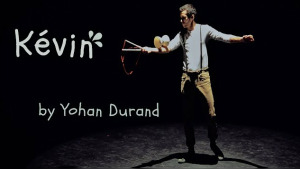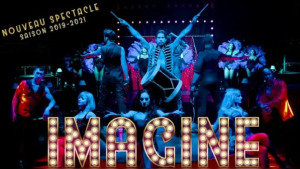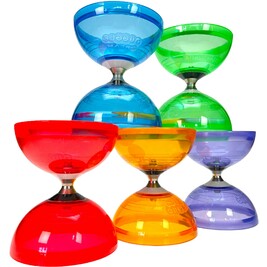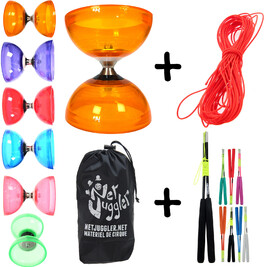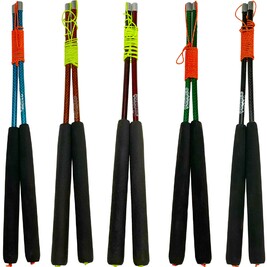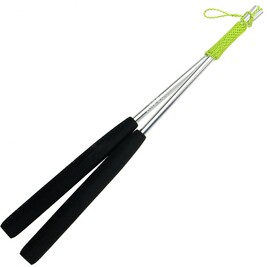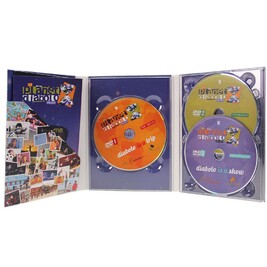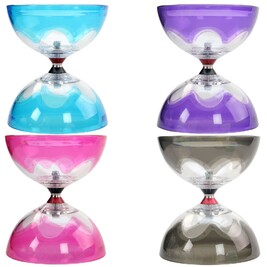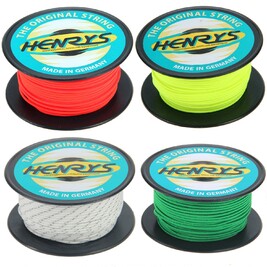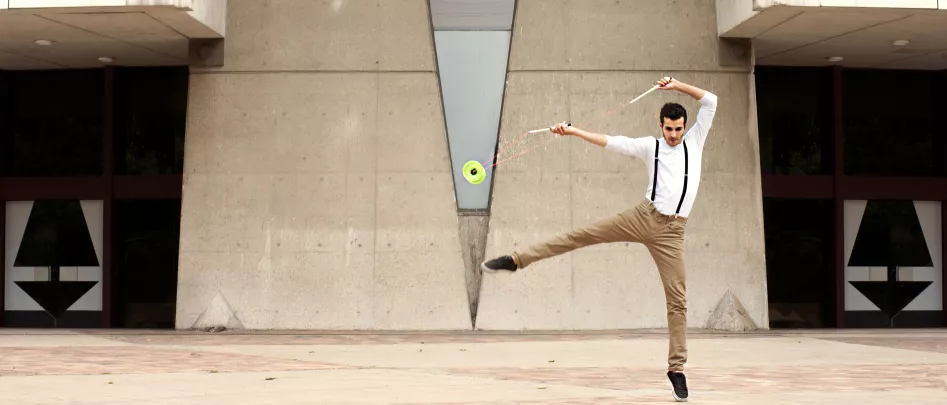
Interview with Yohan DURAND - Diabolist dancer
Between dance and juggling: the unique performance of Yohan Durand
Passion for the diabolo
Since his encounter with a diabolo in 2009, Yohan Durand has not stopped working, gradually building a unique and recognizable artistic style. Self-taught , he has been able to find bridges between dance and juggling , and his need for sharing and discovery has led him to skim numerous stages, with already several creations of 5 to 45 minutes to his credit. He continues today his research work around the dialogue between the body and the object , enriching himself with different techniques from juggling, dance , clowning , puppetry , theater and mime .
Our paths cross regularly when we both work on a festival, me with NetJuggler, Yohan with his shows or at juggling conventions, it was a great exchange for us to prepare this document which retraces Yohan's journey through this interview... And what a journey...
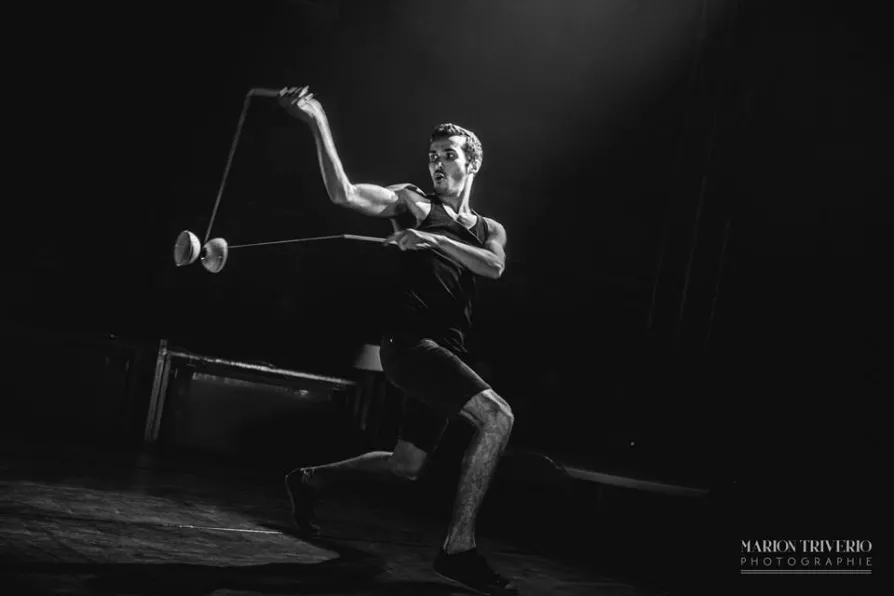
How did you discover diabolo and when did you decide to become a professional artist in this discipline?
I loved it right away, it looked cool. A few months later, I received a red Mister Babache diabolo for Christmas (without asking for it and without ever having spoken to anyone about it). I didn't touch it for a year, however. It gathered dust in a cupboard until I went on holiday for the first time without my big sister. Without much hope, I took it with me. After the first day, it was love at first sight. From that summer in 2009, I literally never let go of it. I juggled almost every day for several hours in my garden or garage, sometimes inspired by videos and a booklet of tricks , but mostly just having fun. Little by little, people around me began to know that I was doing diabolo and I ended up being invited here and there to present acts for free for cycle races, flea markets, Telethons, weddings, birthdays and so on. The real turning point happened one day when I passed in front of the people in charge of the Ille-et-Vilaine Telethon . I thought it would be my chance to be seen and to do even more acts (at the time I didn't imagine being able to be paid for that). But after three hours of results announcements they all preferred to look at their plates rather than me, it was a big disappointment. In any case there wasn't really a stage, not really a sound system or even lighting. Nevertheless, one person came to see me at the end without knowing that he would change my life. He was the host of the evening, he said something like: "Good evening, I have a cabaret in Normandy, would you be interested in coming to work for me?"
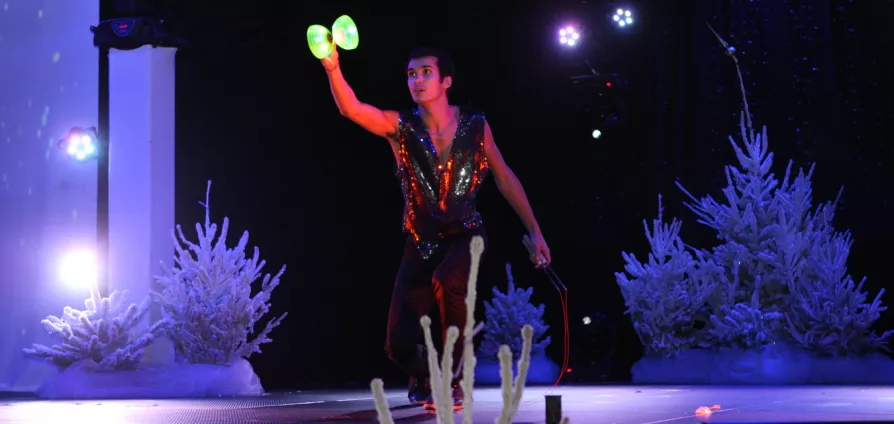
Can you tell us a little about your background and the different training courses you have taken?
My training path is rather fragmented. My training is not about having gone to this or that circus school, it is above all each environment in which I went and where I met people. I first trained through videos and a booklet since there were no other diabolists where I lived in Brittany. However, everything changed when I went to university and met the Rennes jugglers. There I could directly interact with knowledgeable people, share my passion and above all feel a little more at home.
For three years in Rennes, I worked at the Cabaret Fantaisie and learned some of the codes of the stage. There, they told me: "What you're doing with the diabolo is cool, but add something now."
So dance began to enter my practice, mainly self-taught.
A diabolist with "incredible talent" :-)
After a notable appearance on the show "La France a un incroyable talent" in 2015, Yohan Durand has performed on numerous stages, notably at the Cirque Imagine in Lyon and with the Canadian company 7 Doigts de la Main. A little further down in the article, Yohan gives us a testimony about his appearance on the show, I recommend you stay and read it :-).

I appeared in La France à un Incroyable Talent at a time in my life when I wanted to experience the artist's life. I was also wondering if I wanted to work in English, so after a few months of paid shows across France, after a 3-month backpacking trip to Canada where I met a lot of circus artists, after lots of juggling conventions and, above all, after presenting an act at every possible opportunity, I reached important milestones that year.
Back in France after Canada, in 2016, I seriously started busking because I wanted to continue training. In 2016 I went to Lyon for a Master's degree at the university and a new world opened up to me. Above all, I didn't know anyone, no one knew me and I had no money at all. So I went all out. Sometimes without a sound system, other times without a diabolo. The only instruction was to make people stop and manage to earn a little money. I struggled seriously for several months and it finally worked.
On the program of the "Imagine Circus"
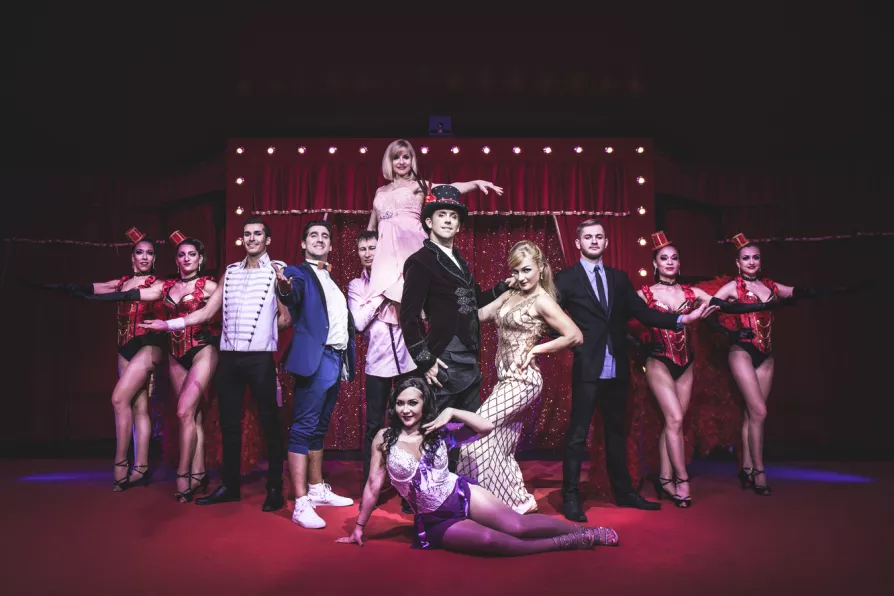
Alongside my studies and the street, I sent hundreds of emails to all kinds of places that could accept my acts , nightclubs, restaurants, bars, anywhere, anytime, I was ready for anything. I only received two responses in the end: one for the inauguration of a nightclub, the other to offer me to come and work in a cabaret-circus for 2 years at the rate of 100 dates per year except summer: Le Cirque Imagine in Lyon . At that time, it was 2017, I was 23 years old, and I was starting to think that I was getting closer to my training objective that I had set for myself. I had now done cabaret, street, TV, conventions... Now, I was going to do traditional circus .
I told myself that all I would have left to do was to do contemporary circus . At Cirque Imagine everything is going well, I do my dates from September to June, I give circus classes , I am doing my master's degree in international business specializing in English shared between classes, an internship in the offices of Cirque Imagine and writing a thesis on the circus . After all that, once summer comes, I can offer my 45-minute long show at different festivals.
In fact, I'm not scheduled enough at the beginning, so for all the festivals I find on my way during the summer, I make sure to find the organizing team and ask them if they have a slot for me to play my show there. And it works, a few years later the show is almost running by itself and I was able to hire someone for the distribution .
The video interview below was made when Yohan was part of the Cirque Imagine team.
Collaboration with "The 7 Fingers of the Hand"
Later, I still tell myself that I still haven't really had a taste of contemporary circus . An advert to work for the company of my dreams passes before my eyes, I tell myself that I could never interest them but luckily I have three days free to go to the auditions in Berlin . At the end of the day, I am told that I was the perfect candidate for this audition, I couldn't believe it.
Here I am, off to work on a contemporary circus project with the 7 Doigts de la Main company . Back to Canada, then a sea tour in the United States begins but the project is finally stopped after a few months because of the arrival of COVID. Today, after all that, I realize that my "training" is still not finished and that it was almost naive to believe that all these experiences would be enough. So I took a theater internship , became interested in mime , puppetry , acrobatics , other circus or juggling apparatus, I read a lot of books on different techniques and aspects of the circus . Everything is going well, I have other projects, lots of other desires waiting for me and I don't intend to stop there.
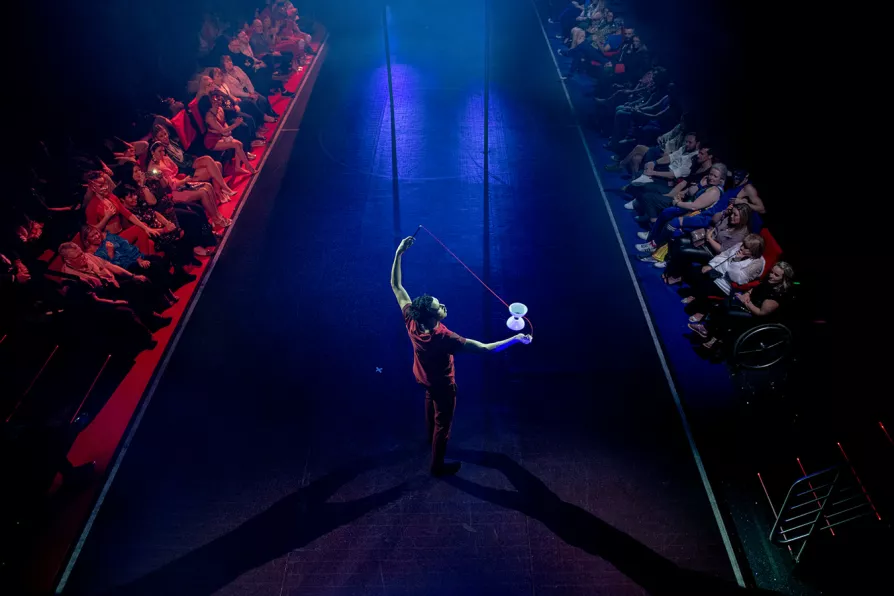
A poetic and touching show: "It's silly but it sticks to your skin"
This acrobat, juggling with dexterity and humor, reconciles us with an art that many thought outdated: the diabolo . Whether it is about the trials or joys of life, let yourself be carried away by the artist's movements, between poetry and finesse. In a total physical and verbal commitment, Yohan Durand invites us to reflect on our own place in the train of life. Whether we are young or old, everyone becomes both spectator and spectacular traveler .
His show "It's stupid but it sticks to the skin," performed more than 149.5 times since 2018, is a truly rhythmic and touching journey to the frontier of the arts. Through juggling with one, two, or even three diabolos, Yohan Durand transports the audience into a poetic and touching universe. His artistic versatility allows him to blend genres, offering a complete experience that goes beyond the limits of a simple diabolo performance. Using dance and street theater, he takes us on an eventful journey aboard the "train of life," inviting the audience to reflect on their own place in the world.
With a catchy soundtrack and moments of pure poetry alternating with more dynamic ones, you'll be swept away by Yohan Durand's art. All while maintaining a sense of humor that appeals to both young and old. If you're a fan of diabolo and shows in general, "It's Silly But It Sticks to the Skin" is a unique show you won't want to miss.
You have a unique artistic style that combines dance and juggling. How did you develop this original approach?
I basically let myself be carried away by my desires and my curiosity. I have a real taste for juggling so I searched and explored the possibilities for a while. I sometimes got bored, I needed other disciplines to refresh my ideas and dance quickly presented itself. Very early on, I wanted to associate the two and try to find links between these two disciplines. I spent a lot of time miming figures as if I had my diabolo in my hands and looking if I didn't have a body part available to make a dance movement. I quickly considered my diabolo as a partner who gave me counterweight, and that's where the real pleasure came for me, between dance and juggling, when the body also becomes an object.
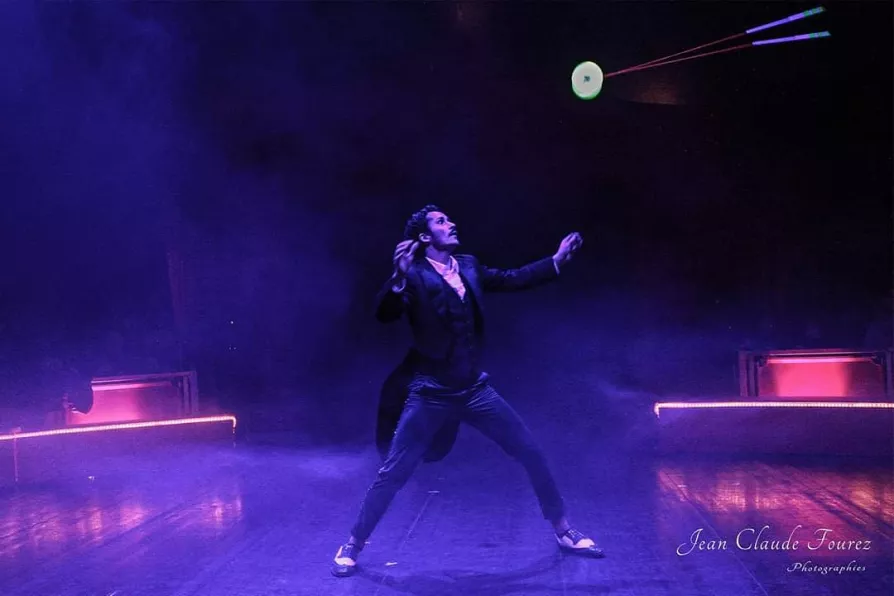
Diabolo workshops: learn the techniques and artistic vision of Yohan Durand
In addition to his shows, Yohan Durand also offers workshops to learn diabolo . Whether for beginners or advanced players, the workshops are suitable for all levels and are an opportunity to learn basic techniques as well as tips for performing more complex tricks . Yohan Durand passes on his know-how with passion and pedagogy, to allow everyone to discover the joys of juggling and diabolo. The workshops are also an opportunity to discover Yohan Durand's artistic universe and understand his vision of the art of diabolo.
The workshops are not just sessions for improving or discovering the diabolo technique . In reality, I try to focus these workshops so that even if one of the learners forgets their diabolo, they can still practice with any other object whatsoever. These are therefore above all sessions around object manipulation , starting from each object (even two diabolos can be different) and taking into account the physical and mental capacities of each person.
How do you prepare your shows? Is there a story you try to tell through your performance?
There is one thing that I regularly experience as a concern and a hindrance to creation, but when it works, it's magical: I like to make sure that all the elements of a number or a show fit together logically.
It's a way of doing things that touches me when I see it reproduced in a show, so I try to do the same in my creations. I consider that writing is an art that makes us understand things through sequences of character, so a series of juggling or dancing movements can also tell something.
The really exciting part is knowing how I'm going to be able to tell this story to an audience that doesn't necessarily have the codes of the different languages I use. So, from one show to another, the approach is different, but for my future creation, for example, I didn't know exactly what I wanted to say. On the other hand, I knew that I wanted to use my diabolo in this or that way. So while waiting for the project to mature in my head, I did pure technical exploration around these diabolo concepts. Which led me to other discoveries that had to be explored. Which led me to other discoveries... At some point, you have to know when to stop and make choices, otherwise you get lost very quickly . For my first long show, I knew where I wanted to go, but I didn't have the technical tools to get there, so I put this show together the hard way. After each attempt at presenting it on stage, it took a little more shape. Five years later, I finally told myself that I didn't want to change it anymore, that it would remain imperfect in places in my eyes, but that I had to move on.
What inspires you in your artistic work?
I believe that all my life choices inspire my artistic work. It's something that has always seemed a bit excessive and disproportionate to say; but deep down, my choices are influenced by the state of my body for each passing day. If I take care of it then I will have more opportunities and possibilities to explore what I can do with it. For my mind and my thoughts, I tell myself that it's the same, so everything influences my artistic work, the "good" as well as the "bad" things in life. Then, as for what inspires me more precisely... I believe that I am deeply touched and impressed when I see a person who completely abandons themselves in what he/she presents on stage or elsewhere. Also, I like to see beautiful technique but it will do absolutely nothing for me if no emotion comes out of the person who proposes this or these techniques on stage. In short, seeing beautiful technique won't do anything for me if it's just beautiful, well executed, and doesn't tell anything profound. I could finally sum it up by the fact that what I find beautiful is what is ugly but honest.
Can you tell us about your experience participating in "France's Got Talent" in 2015?
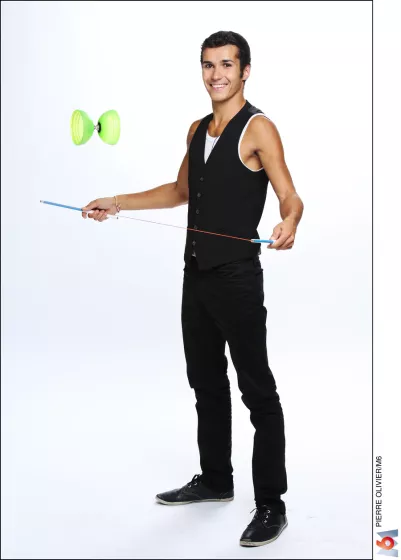
Matthew/NetJuggler: I often talk to recruiters on the phone who are looking for artists for the show. When I ask them how much the artists are paid and they tell me there isn't any, I ask them if they are paid to approach me... Generally, they don't understand my question, and that's the crux of the problem. It's difficult for me to recommend artists to them...
In 20 years of NetJuggler, I've never been able to "send" them any artists. I admit that I have a lot of trouble with the fact that artists aren't paid... There's debate on the subject, but that's my personal point of view.
In my opinion, there is a lack of respect from many artists who appear on the show! They even go so far as not to pay for travel to the recordings. And they are very forceful in their speeches when they talk about promoting the artists while they manipulate the images to serve their story.
I'm very curious to read about your adventure with this project and share it all in this article. Thank you in advance, Yohan, for your testimony :-)
It was in 2015, I was 21 years old, 4 years of diabolo under my belt, some stage experience and above all I didn't know if I wanted to do this with my life.
I was at a pivotal moment, with a degree in literary English in my pocket and a gap year to decide whether I was going to try my luck on stage or in classrooms. Another effect is that it changed my vision of television and "entertainment". Already, I think what saved me was having taken a step back by realizing that it was just a huge play. I was told that on TV it's not you who uses the cameras to gain visibility, it's the other way around. So I told myself that the important thing was to be seen at least once by as many people as possible. My idea was simple, I needed a nice wrapping paper to make the audience and the jury want to see more. The basic scenario was: "Here is Yohan Durand, he is young and learned to play diabolo on his own in his garden, he seems naive but that makes him endearing". Then the gift inside had to hold up, in short, I had to be technically good enough for only 2 minutes on stage. But I also had to be good enough to hold my own in interviews and at every moment I appeared in front of a camera during the long day I was in Paris.
Luckily, I naturally had a naive air. The day was punctuated by waiting and interviews that might never be published, you had to stay pretty focused at all times. Also, I knew it was a good year for a juggler since there hadn't been any the previous year. So there you go, at the very beginning I go through the pre-castings in the regions... and it works! Again, 2 minutes on stage then 30 minutes in an interview where you are told that nothing that will be said there will be shown on TV, only to the production. You are asked questions to test you and see if your image will be worth being shown: "How do you react if you are hated? If you are liked? What do you do with the money if you win? [...]".
Then I went to Paris, at my own expense, or rather at the expense of my family who came with me. When we arrived, we signed a ton of different contracts. We put our makeup on and we quickly put us in the mood and the rhythm of the day. I think the show wanted to put me in the spotlight so I was well received. After a few interviews and fake situations that had to be played in front of the camera, here I am launched on stage, 2 minutes of number, 3 yes out of 4 judges, 5 to 10 minutes of exchange with the jury (only 2 to 3 minutes will finally be shown). One of the judges wanted to press the golden buzzer to send me directly to the semi-final but we prevented him from doing so because that year there had to be a confrontation between jugglers.

After all that, you leave the stage, full of emotions, it's the first day my family agreed to consider diabolo as a possible career path for me. So when you leave the stage there's this long corridor, my family at the end cheering me with real looks of joy but quite quickly we are stopped dead: "Wait, someone walked in front of the camera at the wrong moment, can you do it again?" I'll let you imagine why we never saw this second take on TV. And then there you are, you come down from your emotions and you go home. Until the show is broadcast you have no right to say anything.
Later I came back for the second round, but it consisted of a simple deliberation in front of a jury. Opposite me was Nico Pirès, who also did diabolo and against whom there had to be this famous "confrontation." After this second day in Paris (at their expense this time) spent waiting in a large room between interviews and moments completely staged for the show, we go last.
We knew there was only one spot left, a TV gave out the remaining spots as the other participants paraded in front of the jury. We finally arrived in front of the jury and they told us that Nico would be staying for the rest of the adventure. I was a little disappointed of course, but also very happy for Nico who offered great passages that took him to the final. Another thing I realized later was that the fact that a diabolist was on TV and made it to the final greatly contributed to making diabolo a little more known in France and abroad. Basically, I had achieved my goal and I was right to believe in it because the following year, thanks to the "seen on TV" effect, I was able to taste the life of an artist by traveling all over France for different events.
How did you find your place in the world of juggling and dance, and how have you evolved over the years?
I found my place by never giving up believing in it and by maintaining my passion . I considered myself a juggler and I had this desire to identify myself as such. However, when I arrived in the world of juggling I realized that I arrived with a sort of double handicap. I was doing diabolo, and above all, I was doing diabolo with ball bearings ... At that time, it was really new, almost no one used them, it was even seen as cheating by the other diabolists themselves. Even if the jugglers were almost all very welcoming, I arrived on my side with a lack of self-confidence and a desire to insert myself into a community whose codes I did not have.
Matthew/NetJuggler - It's interesting, I find that you say that you didn't have the codes because for a long time I thought that the community was super approachable, but after bringing non-juggler friends to juggling conventions, I realized that for the shyer ones it wasn't so easy to integrate. Indeed, everything is codified, which doesn't mean that the community isn't welcoming. You sometimes have to prove yourself a little, and I find that a bit of a shame... And at the same time, many of us jugglers are very shy and yet we are "integrated into the community"... In short, it's quite rare that I hear jugglers talk about this subject in this sense... There was a time when religion within the community was what we call BMA (Balls, Clubs, Rings), and the other apparatus were a source of jokes and jokes of questionable taste. Diabolo has long been the beach game for jugglers! But it's evolved a lot in recent years. It must be said that the level is incredible and the disciplines are much more varied.
So I dodged jokes when I needed to, I returned them when I was due, I enjoyed meeting a lot of different people at conventions, I continued to have fun with my diabolo by going on stage whenever possible and it ended up working naturally. It was almost purely subjective but I had become a juggler in my eyes and in the eyes of the community. And what about dance in all of this? Well at that time, the image of juggling that I observed on stage was very often static, almost both feet planted on the ground. I was in full technical progression and in full discovery so it suited me at first. But then I started to see that I was missing something. I had always seen that I was swaying to my music when I went on stage and so I naturally moved towards dance . On the other hand, I am still not completely clear with the fact of considering myself as a dancer. The public did it, several dancers that I respect told me that I was also a dancer. But I think that deep down, even if I have a lot of fun dancing, my too great respect for dance and my too great impression of not knowing how to dance well enough condemn me to remain a juggler who dances , without ever being able to become a dancer who juggles. As long as it remains a source of motivation to always do a little better, then it suits me.
A question that comes up in all our interviews: how do you experience drops during shows? How do you manage them?
At first, I had a hard time with drops because I had never trained myself to manage them. It's a job in itself . You have to learn to tell yourself that during a performance, any mistake is an opportunity to forge a new path . So, on the one hand, I trained myself to find figures and reactions associated with possible drops if they were to happen at a particular moment in the performance. Then I just trained myself not to blame myself in the event of a drop because I quickly realized that it gave a lot of life to my performances. I'm even trying to make it an asset in my next creation by introducing voluntary drops. Where it becomes really fun is when you want to make a drop but it fails... So I learned that what you had to learn to manage wasn't the drops but the unexpected . From there, it gives a completely different presence in the game.
Playing outdoors, what an idea! The weather must play tricks sometimes. How do you deal with the wind? Perhaps some anecdotes?
In the same way as drops, the weather is an unforeseen event . So of course, with all the times I've trained outside, whether it's raining, snowing or windy, on any type of ground... we find solutions . I've seen professional artists used to playing indoors break down the day they had to play outside. The most annoying thing outdoors is clearly the wind . But if you're attentive enough to its strength and direction, then you adapt the strength and direction of your throws constantly. For example, if I have a strong headwind, I'll throw my diabolo forward with a force adapted to the height I'd like it to reach to be sure that it falls back into my strings .
The higher I want to throw it, the harder I have to throw it against the wind. Otherwise, you have to stand sideways to the wind direction when possible, as the wind resistance is less strong there. I've had to juggle three diabolos high up in a changing wind, so I'd throw each diabolo in a completely different direction. They all landed in the same place in the end, despite everything. And I've also had a lot of misses and drops, but when the audience also feels the wind, then it's not a problem, it creates a form of mutual support .
What are your plans for the future as an artist and juggler?
In the future, I would really like to put on other solos, join a collective, or put on a show with several people. Or even just a duo. I've done a lot of solos and I love it, but I would feel even more balanced if I could share the stage from time to time. I would love to do or participate in a show that doesn't concern my specialties. I would also like to do more directing of shows, support young people in their artistic and professional development, give administrative and project management courses for people in circus training, give juggling classes in higher education, be a personal sports coach, write a book on the situation of the circus in France. I still have other projects, but sometimes it's best not to talk about them too much. I'm moving forward little by little; we don't know what tomorrow will bring.
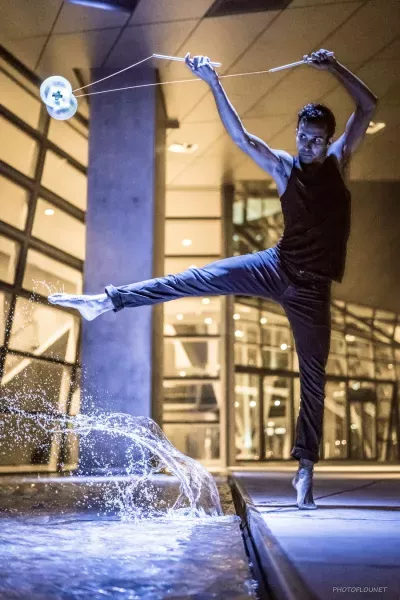
How do you deal with the stress and pressure of making a
show ?
First of all, the best way for me not to be stressed is to be ready on the day of the show. There are always unforeseen events, so if my organization isn't clear, it's the best way to create stress before going on stage. Then, there are days when stress is there no matter what, so you have to learn to accept it and make it a strength. Sometimes it fails, of course, but I try every time to prevent it from taking all my energy. Because for me, these are the worst problems associated with stress; when it prevents me from playing at my best, when it prevents me from having fun, and when it disconnects me from listening to the audience. Over time, I've discovered that what works most often for me is to be well rested, to have enough - or even too much - warm-up time before a show, to meditate if necessary. But above all, to be ready. Last thing, I try not to have a ritual. It's a good way to build confidence, but you have to be careful because there will inevitably be a day when it won't be possible to do this ritual, and then it could be a problem. I don't want to risk finding myself in this position, so each time I change the type of preparation.
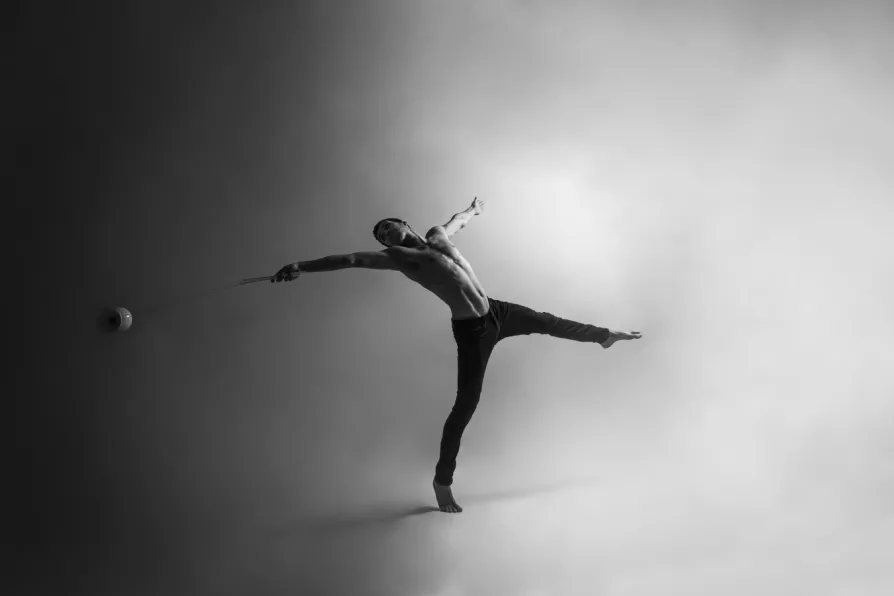
What advice would you have for the younger generations who are already here and who are starting out and embarking on careers related to juggling?
I tend to think that there is no magic recipe. My recipe worked for me, but it's different for everyone. You just have to know that it's possible, there's room for everyone and you can definitely make a living from it. Then I think what you have to tell yourself is that you have to give it your all, stay curious no matter what happens to others and the world around you and be in tune with your needs and desires. That way, even if it doesn't work out then you can at least tell yourself that you did your best. What's most important in my opinion is that it must always remain fun and exciting above all.
A list of your creations?
Creation in progress: "Kawan" (provisional name - 45 min to 1h - planned for mid-2024.
- "The Onion" (30 to 45 min - paused in 2023) trio with Marion Vidal (video) and Lépolod Cordier (sound)
- "Charlie" (5 min), duet with Rotha Thuy (diabolo - breakdance) 2021
- "You, The Disease" (30 min), duet with Ren Datura (dance-theater, lifts and juggling) 2018-2019
- “The Onironnaut” (7min.) diabolos LEDs, 2019
- "Kevin" (5 min), diabolo, dance, 2018
- "Ethereal" (5 min), diabolo, dance, 2017
- “Who’s pulling the strings?” (6min30) diabolo, dance, 2016
- "It's silly but it sticks" (45 min) (juggling, dance, dramatized philosophy) 2016
Thank you, Yohan, for devoting so much time to this interview. Your unique perspective and expertise as a circus artist were invaluable to us. Thank you very much for your contribution to our project.
Thanks to the photographers
To illustrate this article, we used photos from photographers who follow or have followed Yohan Durand's work. Thanks to them:
- Marion Triverio
- Thiery Couly
- Pierre OLIVIER/M6
- Jean Claude Fourez
Learn more
In the video
Comments
!Be the First to comment!
Quartz diabolo kit + Accessories
Triple bearing diabolo, Superglass sticks, 10m Henrys string and bag!
3 DVD box set: Planet Diabolo - Tutorials, film and shows. 100 artists
3 DVD box set on the diabolo + poster + booklet. More than 100 artists filmed.
Glowing HyperSpin Superb diabolo
Diabolo with triple bearings equipped with the Hyperspin 2.0 LED block rechargeable in USB.
25m Henrys professional string
Professional diabolo string. In roll of 25 meters. From the manufacturer Henrys.
